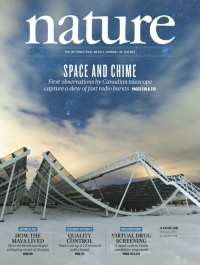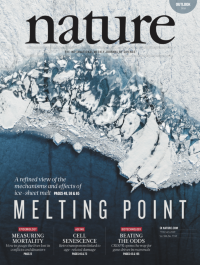Volume 566
-
No. 7745 28 February 2019
Colour creationThe vibrant colours seen on butterfly wings or peacock feathers are examples of structural coloration, which occurs when micro- or nanoscale structured surfaces interfere with visible light. In this week’s issue, Lauren Zarzar and her colleagues reveal a previously unrecognized mechanism for generating structural iridescent colour from droplets of colourless liquid. The researchers found that micrometre-scale droplets suspended on the back of a transparent Petri dish, or multiphase droplets, reflect coloured light from their edges when illuminated with a beam of white light. The effect is not produced by material dispersion, as might be thought, but by an optical phenomenon based on interference of light that undergoes total internal reflection along the curved surface of the droplet. By varying the length and curvature of this interface, the researchers were able to control the colours generated, and by patterning droplets in a 2D array they managed to create pixelated images.
-
No. 7744 21 February 2019
The ecology of researchThe ecosystem of research is evolving. In many areas of science and technology large teams are on the rise, and this collaborative approach has helped to drive advances that would otherwise have been difficult to realize. But questions remain over how big teams operate compared with smaller set-ups. In this issue, James Evans and his colleagues reveal that small and large teams tend to occupy different niches in the landscape of research and development. The researchers analysed more than 65 million papers, patents and software products for the period 1954–2014, assessing to what extent a paper or product is viewed as a new direction or a refinement of prior work. They found that smaller teams (represented on the cover by the handful of sharks) are more likely to disrupt science and technology with new ideas, designs and approaches. By contrast larger teams tend to school together (the smaller fish), consolidating and developing existing ideas. The researchers suggest that both approaches are required to sustain innovation and preserve a healthy ecosystem for science and technology to flourish.
-
No. 7743 14 February 2019
Space and CHIMEThis issue presents the first observations to come from the Canadian Hydrogen Intensity Mapping Experiment (CHIME), a radio telescope located near Penticton in British Columbia. The data were collected while the new instrument was being tested in July and August last year. In the first of two papers, the CHIME/FRB Collaboration reports the observation of 13 fast radio bursts, which were detected at frequencies as low as 400 megahertz. Fast radio bursts are emissions that last about a millisecond and originate far outside the Milky Way, although their emission mechanism is uncertain. Despite substantial searches, such bursts have not previously been detected below 700 MHz. In the companion paper, the collaboration reveals that the source of one of the bursts is actually a repeating fast radio burst, only the second such source to be detected. The researchers suggest this early detection indicates that CHIME is likely to observe a lot more repeating fast radio bursts over its lifetime.
-
No. 7742 7 February 2019
Melting pointTwo papers in this week’s issue focus on the melting ice sheets. In one, Nicholas Golledge and his colleagues examine the cascading effects of melt from the Greenland and Antarctic ice sheets. Using satellite measurements of recent ice-mass changes, the researchers refine current simulations to show that future ice-sheet melt will increase sea level by up to 25 centimetres by 2100, and that this will slow major aspects of ocean circulation, further enhance Antarctic melt and increase climate variability. In a second paper, Tamsin Edwards and her colleagues revisit the controversial marine ice-cliff instability hypothesis, which posits that coastal ice cliffs in Antarctica rapidly collapse when ice shelves melt. The researchers find that ice-cliff collapse is not required to explain past rises in sea level and suggest that this casts doubt on the need to include the hypothesis in projections. As a result, the team’s model predicts that there is only a 5% chance that the Antarctic contribution to sea-level rise will exceed 39 centimetres by 2100.
Nature Outlook




